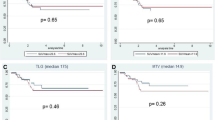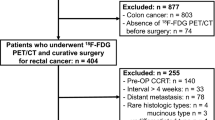Abstract
Background
To evaluate the value of positron emission tomography using fluorodeoxyglucose and computer tomography scan (FDG-PET/CT) for prediction of histopathological response of preoperative radiochemotherapy (RCTX) in patients with rectal carcinoma.
Methods
Thirty patients with uT3 rectal carcinoma were examined by FDG-PET/CT at baseline, 14 days after initiation, and after completion of preoperative RCTX. The FDG decreases seen with PET scanning from baseline to day 14 (early metabolic response) and after completion of therapy (late metabolic response) were compared with histopathological tumor response. One patient denied surgery after RCTX.
Results
The mean (±SD) reduction of tumor FDG uptake in histopathologically responding compared to non-responding tumors was −44.3% (±20.1%) versus −29.6% (±13.1%) (p = 0.085) at day 14 and −66.0% (±20.3%) versus −48.3% (±23.4%) (p = 0.040) after completion of RCTX. Best differentiation of histopathological tumor response was achieved by a cut-off value of 35% reduction of initial FDG uptake at day 14 and 57.5% after completion of therapy. Applying the cut-off values as a criterion for metabolic response, histopathological response was predicted with a sensitivity of 74% (14/19) at day 14 and 79% (15/19) after completion of therapy. The positive predictive value for early metabolic response was 82% (14/17) and for late metabolic response was 83% (15/18). Histopathological evidence of accumulated peritumoral inflammation cells was associated with a minor FDG decrease in five histopathologically responding patients, and influenced the results with negative predictive values of 58% (7/12) and 64% (7/11) at the early and late time points, respectively.
Conclusions
Metabolic response to a preoperative RCTX using FDG-PET/CT in rectal cancer patients can be correlated with histopathological response, but FDG uptake of peritumoral inflammation cells limited the results and led to false negative results.




Similar content being viewed by others
References
Kapiteijn E, Marijnen CAM, Nagtegaal ID et al (2001) Preoperative radiotherapy combined with total mesorectal excision for resectable rectal cancer. N Engl J Med 345:638–646
Sauer R, Becker H, Hohenberger W et al (2004) Preoperative versus postoperative chemoradiotherapy for rectal cancer. N Engl J Med 351:1731–1740
Bosset JF, Collette L, Calais G et al (2006) Chemotherapy with preoperative radiotherapy in rectal cancer. N Engl J Med 355:1114–1123
Bakx R, Emous M, Legemate DA et al (2006) Harm and benefit of short-term pre-operative radiotherapy in patients with resectable rectal carcinomas. Eur J Surg Oncol 32:520–526
Guillem JG, Chessin DB, Cohen AM et al (2005) Long-term oncologic outcome following preoperative combined modality therapy and total mesorectal excision of locally advanced rectal cancer. Ann Surg 241:829–836
Rodel C, Martus P, Papadoupolos T et al (2005) Prognostic significance of tumor regression after preoperative chemoradiotherapy for rectal cancer. J Clin Oncol 23:8688–8696
Rosenberg R, Nekarda H, Zimmermann F et al (2008) Histopathological response after neoadjuvant radiochemotherapy in rectal carcinoma is associated with improved overall survival. J Surg Oncol 97:8–13
Ghadimi BM, Grade M, Difilippantonio MJ et al (2005) Effectiveness of gene expression profiling for response prediction of rectal adenocarcinomas to preoperative chemoradiotherapy. J Clin Oncol 23:1826–1838
Watanabe T, Komuro Y, Kiyomatsu T et al (2006) Prediction of sensitivity of rectal cancer cells in response to preoperative radiotherapy by DNA microarray analysis of gene expression profiles. Cancer Res 66:3370–3374
Rimkus C, Friederichs J, Boulesteix AL et al (2008) Microarray-based prediction of tumor response to neoadjuvant chemoradiotherapy of patients with locally advanced rectal cancer. Clin Gastroenterology Hepatology 6:53–61
Weber WA, Ott K, Dittler HJ et al (2001) Prediction of response to preoperative chemotherapy in adenocarcinomas of the esophaggastric junction by metabolic imaging. J Clin Oncol 19:3058–3065
Ott K, Fink U, Becker K et al (2003) Prediction of response to preoperative chemotherapy in gastric carcinoma by metabolic imaging: results of a prospective trial. J Clin Oncol 21:4604–4610
Ott K, Weber W, Lordick F et al (2006) Metabolic imaging predicts response, survival, and recurrence in adenocarcinoma of the esophagogastric junction. J Clin Oncol 24:4692–4698
Brucher BL, Weber W, Bauer M et al (2001) Neoadjuvant therapy of esophageal squamous cell carcinoma: response evaluation by positron emission tomography. Ann Surg 233:300–309
Amthauer H, Denecke T, Rau B et al (2004) Response prediction by FDG-PET after neoadjuvant radiochemotherapy and combined regional hyperthermia of rectal cancer: correlation with endorectal ultrasound and histopathology. Eur J Med Mol Imaging 31:811–819
Kalff V, Duong C, Drummond EG et al (2006) Findings on 18F-FDG PET scans after neoadjuvant chemoradiation provides prognostic stratification in patients with locally advanced rectal carcinoma subsequently treated by radical surgery. J Nucl Med 47:14–22
Cascini GL, Avallone A, Delrio P et al (2006) 18F-FDG PET is an early predictor of pathologic tumor response to preoperative radiochemotherapy in locally advanced rectal cancer. J Nucl Med 47:1241–1248
Becker K, Mueller JD, Schumacher C et al (2003) Histomorphology and grading of regression in gastric carcinoma treated with neoadjuvant chemotherapy. Cancer 98:1521–1530
Lordick F, Ott K, Krause BJ et al (2007) Use of PET to assess early metabolic response and guide treatment of locally advanced adenocarcinoma of the oesophagus and oesophagogastric junction: a prospective feasibility study. Lancet Oncol 8:797–805
Capirci C, Rampin L, Erba PA et al. FDG-PET/CT reliably predicts response of locally advanced rectal cancer to neo-adjuvant chemo-radiation therapy. Eur J Nucl Med Mol Imaging. 2007 May 15; [Epub ahead of print]
Capirci C, Rubello D, Chierichetti F et al (2006) Long-term prognostic value of 18F-FDG PET in patients with locally advanced rectal cancer previously treated with neoadjuvant radiochemotherapy. Am J Roentgenol 187:202–208
Kao PF, Chou YH, Lai CW (2008) Diffuse FDG uptake in acute prostatitis. Clin Nucl Med 33:308–310
Oku S, Nakagawa K, Momose T et al (2002) FDG-PET after radiotherapy is a good prognostic indicator of rectal cancer. Ann Nucl Med 16:409–416
Saw RP, Morgan M, Koorey D et al (2003) p53, deleted in colorectal cancer gene, and thymidylate synthase as predictors of histopathologic response and survival in low, locally advanced rectal cancer treated with preoperative adjuvant therapy. Dis Colon Rectum 46:192–202
Llamas-Elvira JM, Rodrigues-Fenandez AR, Gutierrez-Sainz J et al (2007) Flourine-18 flourodeoxyglucose PET in the preoperative staging of colorectal cancer. Eur J Nucl Med Mol Imaging 34:859–866
Wieder H, Rosenberg R, Lordick F et al (2007) Magnetic resonance imaging in patients with rectal cancer before neoadjuvant radiochemotherapy for prediction of tumor-free circumferential resection margins and long-term survival. Radiology 243:744–751
Wieder HA, Geinitz H, Rosenberg R et al (2007) PET imaging with (18F) 3′-deoxy-3′-flourothymidine for prediction of response to neoadjuvant treatment in patients with rectal cancer. Eur J Nucl Med Mol Imaging 34:878–883
Denecke T, Rau B, Hoffmann KT et al (2005) Comparison of CT, MRI and FDG-PET in response prediction of patients with locally advanced rectal cancer after multimodal preoperative therapy: is there a benefit in using functional imaging? Eur Radiol 15:1658–1666
Author information
Authors and Affiliations
Corresponding author
Rights and permissions
About this article
Cite this article
Rosenberg, R., Herrmann, K., Gertler, R. et al. The predictive value of metabolic response to preoperative radiochemotherapy in locally advanced rectal cancer measured by PET/CT. Int J Colorectal Dis 24, 191–200 (2009). https://doi.org/10.1007/s00384-008-0616-8
Accepted:
Published:
Issue Date:
DOI: https://doi.org/10.1007/s00384-008-0616-8




